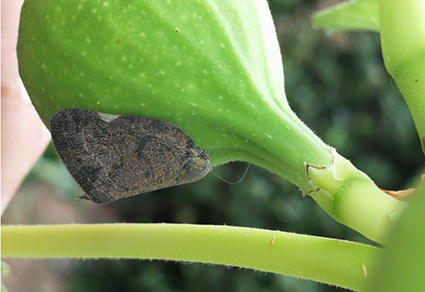Abstract
The invasive ricaniid species Pochazia shantungensis (Chou & Lu, 1977), an Asiatic pest in China and Korea, is reported for the first time in Italy. This is the fourth confirmed record from Europe after Turkey, France, and Germany. The list of the host plants recorded in Europe is given. Illustrations of male and female genital structures (external and internal) are also presented.
References
Baek, S., Kim, M.-J. & Lee, J.H. (2019) Current and future distribution of Ricania shantungensis (Hemiptera: Ricaniidae) in Korea: application of spatial analysis to select relevant environmental variables for MaxEnt and CLIMEX Modeling. Forests, 10, 490. https://doi.org/10.3390/f10060490
Bourgoin, T. (1993) Female genitalia in Hemiptera Fulgoromorpha, morphological and phylogenetic data. Annales de la Société Entomologique de France, 29 (3), 225–244
Bourgoin, T., Gros, P. & Stroiński, A. (2020) Pochazia shantungensis (Chou & Lu, 1977), an important Asiatic invasive pest on fruit trees, first time reported from France (Hemiptera, Fulgoromorpha, Ricaniidae). Bulletin de la Société entomologique de France, 125 (3), 271–272. https://doi.org/10.32475/bsef_2150
Choi, D.-S., Ko, S.-J., Ma, K.-C., Kim, H.-J., Lee, J.-H. & Kim, D.-I. (2016) Effect of temperature on hatchability of overwintering eggs and nymphal development of Ricania shantungensis (Hemiptera: Ricaniidae). Journal of Applied Entomology, 55 (4), 453–457. [in Korean with English abstract]. https://doi.org/10.5656/ksae.2016.11.0.029
Chou, I. & Lu, C. (1977) On the Chinese Ricaniidae with descriptions of eight new species. Acta Entomologica Sinica, 20 (3), 314–322.
Drew, K., Anderson, N. & Andow, D. (2010) Conundrums of a complex vector for invasive species control: a detailed examination of the horticultural industry. Biological Invasions, 12, 2837–2851. https://doi.org/10.1007/s10530-010-9689-8
EPPO (2021) Pochazia shantungensis (Hemiptera: Ricaniidae) EPPO RS 2021/130. Available from: https://www.eppo.int/ACTIVITIES/plant_quarantine/alert_list_insects/pochazia_shantungensis (accessed 21 June 2022)
FAO [Food and Agriculture Organization of the United Nations] (2011) Guide to implementation of phytosanitary standards in forestry. FAO Forestry Paper, 164, i–xi + 1–101.
Hizal, E., Oztemiz, S. & Gjonov, I. (2019) Ricania shantungensis Chou & Lu 1977 (Hemiptera: Fulgoromorpha: Ricaniidae) a new invasive insect species in European Turkey. Fresenius Environmental Bulletin, 28 (12A), 9816–9820.
Inghilesi, A.F., Mazza, G., Cervo, R., Gherardi, F., Sposimo, P., Tricarico, E. & Zapparoli, M. (2013) Alien insects in Italy: Comparing patterns from the regional to European level. Journal of Insect Science, 13 (73). Available from: http://www.insectscience.org/13.73 (accessed 3 September 2014) https://doi.org/10.1673/031.013.7301
JKI [Julius Kühn-Institut—Federal Research Centre for Cultivated Plants, Institute for National and International Plant Health] (2021) PRA for Pochazia shantungensis. 8 pp. Available from: https://pflanzengesundheit.julius-kuehn.de/en/pest-risk-analyses.html (accessed 6 September 2022)
Mazza, G., Pennacchio, F., Gargani, E., Franceschini, I., Roversi, P.F. & Cianferoni, F. (2014) First report of Ricania speculum (Walker, 1851) in Europe (Hemiptera: Fulgoromorpha: Ricaniidae). Zootaxa, 3861 (3), 297–300. https://doi.org/10.11646/zootaxa.3861.3.7
Mazza, G., Marraccini, D., Lucchi, A., Marianelli, L., Sabbatini Peverieri, G., Bosio, G., Giacometto, E., Rapa, L., Cianferoni, F., Roversi, P.F. & Gargani, E. (2018) First record of Ricania speculum (Walker, 1851) (Hemiptera: Ricaniidae) from Veneto, Piedmont and Latium regions and new host plants. Redia, 101, 197–200. https://doi.org/10.19263/REDIA-101.18.27
Mazza, G., Marraccini, D., Mori, E., Priori, S., Marianelli, L., Roversi, P.F. & Gargani, E. (2020) Assessment of color response and activity rhythms of the invasive black planthopper Ricania speculum (Walker, 1851) using sticky traps. Bulletin of Entomological Research, 110 (4), 480–486. https://doi.org/10.1017/S000748531900083X
Reichard, S.H. & White, P. (2001) Horticulture as a pathway of invasive plant introductions in the United States. BioScience, 51 (2), 103–113. https://doi.org/10.1641/0006-3568(2001)051[0103:HAAPOI]2.0.CO;2
Shorthouse, D.P. (2010) SimpleMappr, an online tool to produce publication-quality point maps. Available from: http://www.simplemappr.net (accessed 8 August 2022)
Stroiński, A. & Bourgoin, T. (2022) On the taxonomic position of Pochazia shantungensis (Chou and Lu, 1977) (Hemiptera, Fulgoromorpha, Ricaniidae). Bulletin de la Société entomologique de France. [in press]
Tropicos.org (2022) Tropicos. Version 3.3.2. 14 June 2022. Missouri Botanical Garden, St. Louis, Missouri. [program]


